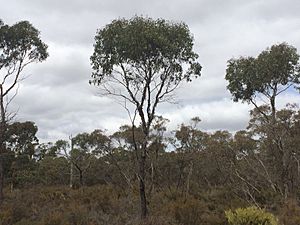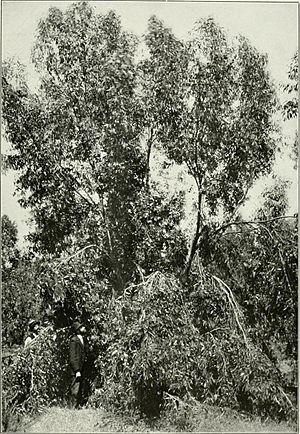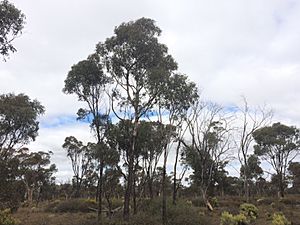Flat-topped yate facts for kids
Quick facts for kids Flat-topped yate |
|
|---|---|
 |
|
| Scientific classification | |
| Genus: |
Eucalyptus
|
| Species: |
occidentalis
|
| Synonyms | |
|
Eucalyptus agnata Domin Eucalyptus occidentalis var. occidentalis |
|
The Eucalyptus occidentalis, also known as the flat-topped yate or swamp yate, is a special tree from Western Australia. The local Noongar people call it Mo or Yundill. This tree is known for its unique shape and how it helps the environment.
Contents
What is the Flat-topped Yate?
How Does it Look?
This tree or mallee (a type of eucalyptus that grows like a shrub) usually grows between 4 and 25 metres (about 13 to 82 feet) tall. Its trunk can be about 0.5 metres (1.6 feet) wide. It often has a short trunk that branches out low down. These branches form a wide, umbrella-like top.
The bark on the main trunk is rough and dark grey or black. But on the upper trunk and branches, the bark is smooth and white, sometimes even powdery. Its adult leaves are shiny green and shaped like a spear. Younger leaves are dull blue-green and wider. This tree flowers quite early, often in its first year. It produces creamy-white flowers from September to May. The seeds are blackish-brown and are found inside its fruit.
Where Does it Grow?
The flat-topped yate naturally grows near rivers and in hilly, rocky areas along the south coast of Western Australia. You can find it in the Great Southern region, stretching north into the southern Wheatbelt and east into the Goldfields-Esperance areas. It prefers sandy or clay soils.
This tree is also planted in many other places. It grows well in drier parts of Victoria, South Australia, and central southern New South Wales. It's also widely planted in other warm parts of the world, like Italy, Morocco, Chile, Mexico, and Israel.
How Was it Named?
The flat-topped yate was first officially described in 1837 by a botanist named Stephan Endlicher. He wrote about it in a book called Enumeratio plantarum. The information came from samples collected by Charles von Hügel near King George Sound. Later, in 1913, another botanist named Karel Domin described a similar tree, Eucalyptus agnata. We now know that Eucalyptus agnata is the same species as Eucalyptus occidentalis.
Living with Other Plants and Animals
Eucalyptus occidentalis often forms its own groups in woodlands. Sometimes, it grows alongside other eucalyptus trees like Eucalyptus wandoo and Eucalyptus salmonophloia. Smaller trees like Melaleuca strobophylla and Acacia cyclops might also be found nearby. The ground beneath these trees is often covered with shrubs, herbs, grasses, and sedges.
Like many plants, the flat-topped yate can be affected by insects. In Western Australia, tiny insects called lerp and gumleaf skeletoniser can cause damage. In New South Wales, leaf beetles can sometimes harm the leaves. Even though these insects can cause problems, the trees usually recover.
What is it Used For?
The flat-topped yate is very useful! It's often planted in wet areas, even salty ones, to help keep the soil in place. This helps prevent soil from washing away. It can grow in places that get little rain, have frosts, and sometimes experience droughts.
The wood from this tree is strong and can be used for timber. In countries like Israel and Chile, it's used for building, firewood, making charcoal, and pulp. In Australia, people plant it to create windbreaks, which protect farms from strong winds. It also provides shade for animals. The tree is also good for beekeeping and honey production. Its hard, pale wood is suitable for making furniture and for construction, especially in damp soils.




